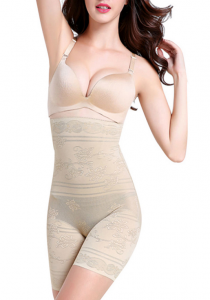Donna Loveday, co curator high waist bodyshaper of Women Fashion Power, wants to get one thing clear from the start, when we meet at her office in the Design Museum: this is not, repeat not, an exhibition about power dressing. „I have deliberately avoided using that term. I don’t feel it represents either the way women think, or the way they dress” she says.
Power dressing it may not be, but this is undoubtedly a timely show. The discourse around how women in positions of power and influence dress has never been more fractious. In July, coverage of the appointment of new female cabinet ministers that labelled it the Downing Street Catwalk whipped up a media firestorm. But – as befits a show dominated by such figures as Margaret Thatcher, Angela Merkel and Joan of Arc – this is no passive taking of minutes on the contemporary argument. Instead, it is an exhibition with a strong agenda.
That agenda is to frame women as the protagonists in the story of what they wear, rather than the victims of fashion. Loveday talks a lot about „how women use clothes”, a format that places women in a dynamic role in their relationship with fashion, rather than seeing them as bound and enslaved by it. And there is another, deeper subversion. Fashion has become a popular subject for museum exhibitions, which tend naturally to place the designer in the spotlight, as artist and hero and creator. In this show, „the women are the heroes, not the designers”, says Loveday. How do designers – traditionally portrayed as the originators of new ideas in fashion – fit into this new picture? „Designers are looking at women. Women are the muses of fashion, and designers are responding to what they want and need, and particularly to changes in those wants and needs.”
Loveday wants the exhibition to be „the start of a conversation”, one which will nudge the discussion around women, power and fashion into a more positive light. After all, the phrase power dressing is inextricably linked to a specific look – the huge shouldered, Dynasty boardroom suit – which represents a moment in history when women were breaking into traditionally male roles at a rate never seen before. It seems to link these suits to dressing up box costumes: there is a whisper lurking somewhere in this expression that power dressing is suspect, that women are dressed for roles they cannot or should not do.
By talking about women, clothes and society rather than about power dressing, Loveday wants to leave behind some of that negativity along with the words. As she says, „fashion is a language, after all”. The concept for the exhibition „came from a team meeting – I can’t take credit for it”, says Loveday. Her co curator is the fashion writer and historian Colin McDowell, and the exhibition is designed by Zaha Hadid. The show will be officially unveiled by Anne Hidalgo, the first ever female mayor of Paris.
At the time of our meeting the show was yet to be installed, but it will open, says Loveday, with a section devoted to „identifying power through dress”, with images ranging from Boudicca and Elizabeth I to Hillary Clinton. This will be followed by a timeline, which is „not a history of fashion” but highlights key moments of political and social change from 1850 to today, as seen through the prism of what women wear. The choice of starting point is deliberate, at the height of the craze for tiny waisted corsets: a corset with an 18 inch waist is the starting point for the story of dress reform, and how incremental societal shifts, rather than seasonal trends, drove changes toward a loosened up silhouette.


